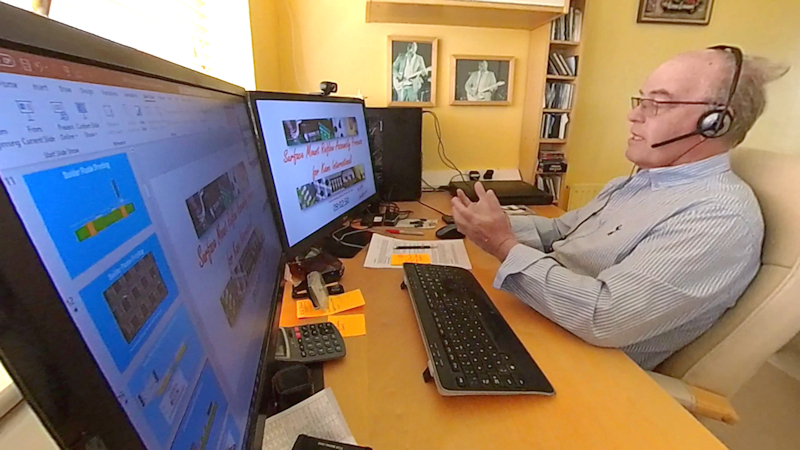
I will be presenting two three hour workshops on Robotic Soldering Process, Design, Quality Control & Defects – Causes & Cures and Practical Use of Low Temperature Solder, Assembly, Reflow & Inspection on 14th and 16th December as part of the SMTA International Virtual Conference
 Robotic soldering with Low Temperature Solder (LTS) was a success, but there is still more to learn. We recently processed two of our Robotic Soldering Experience test boards with SnBiAg and SnBi cored solder wire from Jufeng China. Cored wire suppliers are limited in the marketplace due to the difficult in forming the wire with a core of flux. We used both gold over nickel and copper OSP surface finish on 4-layer boards provided by ALR Services in the UK. The tin and gold-plated post header connectors were produced by Wurth Elektronik. The team at Promation USA were kind enough to run the boards based on my evaluation plan at 240oC set point, the wire reflows at 140oC. After initial setup we exceeded the requirements of IPC 610 level 3 with the joints formed on both top and bottom of the boards. The connector masks the top side fillets but removing part of the plastic connector body allows selected joints to be examined. Currently selected connector positions are being examined by x-ray. Samples taken from our boards will be temperature cycled over the coming weeks to see any impact these are to be tested at Henkel in the UK. Also included will be samples from a wave soldering trial
Robotic soldering with Low Temperature Solder (LTS) was a success, but there is still more to learn. We recently processed two of our Robotic Soldering Experience test boards with SnBiAg and SnBi cored solder wire from Jufeng China. Cored wire suppliers are limited in the marketplace due to the difficult in forming the wire with a core of flux. We used both gold over nickel and copper OSP surface finish on 4-layer boards provided by ALR Services in the UK. The tin and gold-plated post header connectors were produced by Wurth Elektronik. The team at Promation USA were kind enough to run the boards based on my evaluation plan at 240oC set point, the wire reflows at 140oC. After initial setup we exceeded the requirements of IPC 610 level 3 with the joints formed on both top and bottom of the boards. The connector masks the top side fillets but removing part of the plastic connector body allows selected joints to be examined. Currently selected connector positions are being examined by x-ray. Samples taken from our boards will be temperature cycled over the coming weeks to see any impact these are to be tested at Henkel in the UK. Also included will be samples from a wave soldering trial
 The test board design featured a range of inner layer connection points to the ground plane to create heat drain during soldering as most standard robotic soldering system installations do not feature preheat. However, this is perfectly feasible to implement as we have done on inline systems. The inner layer connection tracks points varied in width and number to the plated through hole which would be apparent during x-ray inspection. Six connector positions also featured teardrop pads which can be useful on other soldering systems to allow direct contact with the soldering iron to increase heat transfer. Selected low specification systems in the marketplace do also operate with direct contact as a reference point for height. Larger pads particularly on heavier tracking can benefit from this design technique. They also allow the solder wetting to be compared in production provided the volume of solder is not increased to accommodate the greater surface area
The test board design featured a range of inner layer connection points to the ground plane to create heat drain during soldering as most standard robotic soldering system installations do not feature preheat. However, this is perfectly feasible to implement as we have done on inline systems. The inner layer connection tracks points varied in width and number to the plated through hole which would be apparent during x-ray inspection. Six connector positions also featured teardrop pads which can be useful on other soldering systems to allow direct contact with the soldering iron to increase heat transfer. Selected low specification systems in the marketplace do also operate with direct contact as a reference point for height. Larger pads particularly on heavier tracking can benefit from this design technique. They also allow the solder wetting to be compared in production provided the volume of solder is not increased to accommodate the greater surface area
 In this short exercise we have learnt many different aspects of LTS and some unexpected adding to our existing knowledge of processing high temperature cored wire. This adds to the content of our hands on and online workshops, helping companies evaluate the implementation of the technology. In addition, it will also provide more benefits in running the Robotic Soldering Experience with suppliers in the coming months with SAC and LTS solders. We hope to be joined by Promation USA and all of the robotic soldering and material suppliers when we relaunch the Robotic Soldering Experience project this year with more webinars and public events. To find out more and view our past Defect of the Month, launch webinar videos and how this project is being run visit https://lnkd.in/dCarhXG
In this short exercise we have learnt many different aspects of LTS and some unexpected adding to our existing knowledge of processing high temperature cored wire. This adds to the content of our hands on and online workshops, helping companies evaluate the implementation of the technology. In addition, it will also provide more benefits in running the Robotic Soldering Experience with suppliers in the coming months with SAC and LTS solders. We hope to be joined by Promation USA and all of the robotic soldering and material suppliers when we relaunch the Robotic Soldering Experience project this year with more webinars and public events. To find out more and view our past Defect of the Month, launch webinar videos and how this project is being run visit https://lnkd.in/dCarhXG
 In addition, we also have a proposed plan for a complete Low Temperature Soldering Experience like our past well know production features at exhibitions at IPC APEX, Productronica, SMT Nuremberg, SMTA International and in the past Nepcon. If you would like to be involved in this activity just let us know
In addition, we also have a proposed plan for a complete Low Temperature Soldering Experience like our past well know production features at exhibitions at IPC APEX, Productronica, SMT Nuremberg, SMTA International and in the past Nepcon. If you would like to be involved in this activity just let us know


